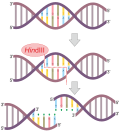Nuclease: Difference between revisions
CSV import |
CSV import |
||
| Line 39: | Line 39: | ||
{{stub}} | {{stub}} | ||
<gallery> | |||
File:HindIII_Restriction_site_and_sticky_ends_vector.svg|HindIII Restriction Site and Sticky Ends | |||
File:EcoRV_structure.png|EcoRV Structure | |||
</gallery> | |||
Latest revision as of 00:46, 18 February 2025
Nuclease is a type of enzyme that is capable of cleaving the phosphodiester bonds which link the nucleotides of nucleic acids. Nucleases are divided into two broad categories: endonucleases and exonucleases.
Function[edit]
Nucleases play a crucial role in many biological processes, including DNA replication, DNA repair, and apoptosis. They are involved in the maintenance and repair of genetic material, and in the regulation of gene expression.
Types[edit]
There are two main types of nucleases: endonucleases and exonucleases.
Endonucleases[edit]
Endonucleases cleave phosphodiester bonds within a nucleic acid chain. They are further classified into restriction endonucleases and non-restriction endonucleases.
Exonucleases[edit]
Exonucleases remove nucleotides from the ends of DNA or RNA molecules. They are further classified into 3'-5' exonucleases and 5'-3' exonucleases.
Role in Biotechnology[edit]
Nucleases have a significant role in biotechnology and genetic engineering. They are used in molecular cloning, gene therapy, and CRISPR technology.
See Also[edit]
References[edit]
<references />




